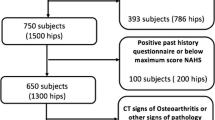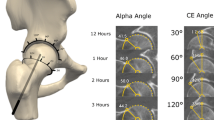Abstract
An objective measurement technique to quantify 3D femoral head shape was developed and applied to normal subjects and patients with cam-type femoroacetabular impingement (FAI). 3D reconstructions were made from high-resolution CT images of 15 cam and 15 control femurs. Femoral heads were fit to ideal geometries consisting of rotational conchoids and spheres. Geometric similarity between native femoral heads and ideal shapes was quantified. The maximum distance native femoral heads protruded above ideal shapes and the protrusion area were measured. Conchoids provided a significantly better fit to native femoral head geometry than spheres for both groups. Cam-type FAI femurs had significantly greater maximum deviations (4.99 ± 0.39 mm and 4.08 ± 0.37 mm) than controls (2.41 ± 0.31 mm and 1.75 ± 0.30 mm) when fit to spheres or conchoids, respectively. The area of native femoral heads protruding above ideal shapes was significantly larger in controls when a lower threshold of 0.1 mm (for spheres) and 0.01 mm (for conchoids) was used to define a protrusion. The 3D measurement technique described herein could supplement measurements of radiographs in the diagnosis of cam-type FAI. Deviations up to 2.5 mm from ideal shapes can be expected in normal femurs while deviations of 4–5 mm are characteristic of cam-type FAI.






Similar content being viewed by others
References
Almoussa, S., C. Barton, A. D. Speirs, W. Gofton, and P. E. Beaule. Computer-assisted correction of cam-type femoroacetabular impingement: a sawbones study. J. Bone Joint Surg. Am. 93(Suppl 2):70–75, 2011.
Anda, S., T. Terjesen, K. A. Kvistad, and S. Svenningsen. Acetabular angles and femoral anteversion in dysplastic hips in adults: Ct investigation. J. Comput. Assist. Tomogr. 15:115–120, 1991.
Anderson, A. E., B. J. Ellis, S. A. Maas, and J. A. Weiss. Effects of idealized joint geometry on finite element predictions of cartilage contact stresses in the hip. J. Biomech. 43:1351–1357, 2010.
Anderson, A. E., B. J. Ellis, C. L. Peters, and J. A. Weiss. Cartilage thickness: factors influencing multidetector ct measurements in a phantom study. Radiology 246:133–141, 2008.
Anderson, A. E., C. L. Peters, B. D. Tuttle, and J. A. Weiss. Subject-specific finite element model of the pelvis: development, validation and sensitivity studies. J. Biomech. Eng. 127:364–373, 2005.
Audenaert, E. A., N. Baelde, W. Huysse, L. Vigneron, and C. Pattyn. Development of a three-dimensional detection method of cam deformities in femoroacetabular impingement. Skeletal Radiol. 40:921–927, 2011.
Audenaert, E. A., I. Peeters, S. Van Onsem, and C. Pattyn. Can we predict the natural course of femoroacetabular impingement? Acta Orthop. Belg. 77:188–196, 2011.
Barton, C., M. J. Salineros, K. S. Rakhra, and P. E. Beaule. Validity of the alpha angle measurement on plain radiographs in the evaluation of cam-type femoroacetabular impingement. Clin. Orthop. Relat. Res. 469:464–469, 2011.
Beaule, P. E., E. Zaragoza, K. Motamedi, N. Copelan, and F. J. Dorey. Three-dimensional computed tomography of the hip in the assessment of femoroacetabular impingement. J. Orthop. Res. 23:1286–1292, 2005.
Byrd, J. W., and K. S. Jones. Arthroscopic femoroplasty in the management of cam-type femoroacetabular impingement. Clin. Orthop. Relat. Res. 467:739–746, 2009.
Carlisle, J. C., L. P. Zebala, D. S. Shia, D. Hunt, P. M. Morgan, H. Prather, R. W. Wright, K. Steger-May, and J. C. Clohisy. Reliability of various observers in determining common radiographic parameters of adult hip structural anatomy. Iowa Orthop. J. 31:52–58, 2011.
Cerveri, P., A. Manzotti, and G. Baroni. Patient-specific acetabular shape modelling: comparison among sphere, ellipsoid and conchoid parameterisations. Comput. Methods Biomech. Biomed. Eng. 2012. doi:10.1080/10255842.2012.702765
Clohisy, J. C., J. C. Carlisle, R. Trousdale, Y. J. Kim, P. E. Beaule, P. Morgan, K. Steger-May, P. L. Schoenecker, and M. Millis. Radiographic evaluation of the hip has limited reliability. Clin. Orthop. Relat. Res. 467:666–675, 2009.
Clohisy, J. C., J. C. Carlisle, P. E. Beaule, Y. J. Kim, R. T. Trousdale, R. J. Sierra, M. Leunig, P. L. Schoenecker, and M. B. Millis. A systematic approach to the plain radiographic evaluation of the young adult hip. J. Bone Joint Surg. Am. 90(Suppl 4):47–66, 2008.
Clohisy, J. C., L. P. Zebala, J. J. Nepple, and G. Pashos. Combined hip arthroscopy and limited open osteochondroplasty for anterior femoroacetabular impingement. J. Bone Joint Surg. Am. 92:1697–1706, 2010.
Clohisy, J. C., R. M. Nunley, R. J. Otto, and P. L. Schoenecker. The frog-leg lateral radiograph accurately visualized hip cam impingement abnormalities. Clin. Orthop. Relat. Res. 462:115–121, 2007.
Domayer, S. E., K. Ziebarth, J. Chan, S. Bixby, T. C. Mamisch, and Y. J. Kim. Femoroacetabular cam-type impingement: diagnostic sensitivity and specificity of radiographic views compared to radial MRI. Eur. J. Radiol. 80(3):805–810, 2011.
Dudda, M., C. Albers, T. C. Mamisch, S. Werlen, and M. Beck. Do normal radiographs exclude asphericity of the femoral head-neck junction? Clin. Orthop. Relat. Res. 467:651–659, 2009.
Eijer, H., M. Leunig, N. Mahomed, and R. Ganz. Cross table lateral radiographs for screening of anterior femoral head-neck offset in patients with femoro-acetabular impingement. Hip Int. 11:37–41, 2001.
Ganz, R., J. Parvizi, M. Beck, M. Leunig, H. Notzli, and K. A. Siebenrock. Femoroacetabular impingement: a cause for osteoarthritis of the hip. Clin. Orthop. Relat. Res. 417:112–120, 2003.
Ganz, R., T. J. Gill, E. Gautier, K. Ganz, N. Krugel, and U. Berlemann. Surgical dislocation of the adult hip a technique with full access to the femoral head and acetabulum without the risk of avascular necrosis. J. Bone Joint Surg. Br. 83(8):1119–1124, 2001.
Harris, W. H. Etiology of osteoarthritis of the hip. Clin. Orthop. Relat. Res. 213:20–33, 1986.
Ito, K., M. A. Minka, 2nd, M. Leunig, S. Werlen, and R. Ganz. Femoroacetabular impingement and the cam-effect. A MRI-based quantitative anatomical study of the femoral head-neck offset. J. Bone Joint Surg. Br. 83:171–176, 2001.
Kapron, A. L., A. E. Anderson, S. K. Aoki, L. G. Phillips, D. J. Petron, R. Toth, and C. L. Peters. Radiographic prevalence of femoroacetabular impingement in collegiate football players: Aaos exhibit selection. J. Bone Joint Surg. Am. 93:e111(111-110), 2011.
Konan, S., F. Rayan, and F. S. Haddad. Is the frog lateral plain radiograph a reliable predictor of the alpha angle in femoroacetabular impingement? J. Bone Joint Surg. Br. 92:47–50, 2010.
Lavigne, M., J. Parvizi, M. Beck, K. A. Siebenrock, R. Ganz, and M. Leunig. Anterior femoroacetabular impingement: part i. Techniques of joint preserving surgery. Clin. Orthop. Relat. Res. 418:61–66, 2004.
Lavigne, M., M. Kalhor, M. Beck, R. Ganz, and M. Leunig. Distribution of vascular foramina around the femoral head and neck junction: relevance for conservative intracapsular procedures of the hip. Orthop. Clin. N. Am. 36(2):171–176, viii, 2005.
Mardones, R. M., C. Gonzalez, Q. Chen, M. Zobitz, K. R. Kaufman, and R. T. Trousdale. Surgical treatment of femoroacetabular impingement: evaluation of the effect of the size of the resection. Surgical technique. J. Bone Joint Surg. Am. 88(Suppl 1 Pt 1):84–91, 2006.
Matsuda, D. K. The case for cam surveillance: the arthroscopic detection of cam femoroacetabular impingement missed on preoperative imaging and its significance. Arthroscopy 27:870–876, 2011.
Meermans, G., S. Konan, F. S. Haddad, and J. D. Witt. Prevalence of acetabular cartilage lesions and labral tears in femoroacetabular impingement. Acta Orthop. Belg. 76:181–188, 2010.
Menschik, F. The hip joint as a conchoid shape. J. Biomech. 30:971–973, 1997.
Metz, C. T. Digitally Reconstructed Radiographs. Utrecht: Utrecht University, p. 79, 2005.
Meyer, D. C., M. Beck, T. Ellis, R. Ganz, and M. Leunig. Comparison of six radiographic projections to assess femoral head/neck asphericity. Clin. Orthop. Relat. Res. 445:181–185, 2006.
Nepple, J. J., J. C. Carlisle, R. M. Nunley, and J. C. Clohisy. Clinical and radiographic predictors of intra-articular hip disease in arthroscopy. Am. J. Sports Med. 39:296–303, 2011.
Notzli, H. P., T. F. Wyss, C. H. Stoecklin, M. R. Schmid, K. Treiber, and J. Hodler. The contour of the femoral head-neck junction as a predictor for the risk of anterior impingement. J. Bone Joint Surg. Br. 84:556–560, 2002.
Pfirrmann, C. W., B. Mengiardi, C. Dora, F. Kalberer, M. Zanetti, and J. Hodler. Cam and pincer femoroacetabular impingement: characteristic mr arthrographic findings in 50 patients. Radiology 240:778–785, 2006.
Philippon, M. J., R. B. Maxwell, T. L. Johnston, M. Schenker, and K. K. Briggs. Clinical presentation of femoroacetabular impingement. Knee Surg. Sports Traumatol. Arthrosc. 15:1041–1047, 2007.
Philippon, M. J., M. L. Schenker, K. K. Briggs, D. A. Kuppersmith, R. B. Maxwell, and A. J. Stubbs. Revision hip arthroscopy. Am. J. Sports Med. 35:1918–1921, 2007.
Pollard, T. C., R. N. Villar, M. R. Norton, E. D. Fern, M. R. Williams, D. J. Simpson, D. W. Murray, and A. J. Carr. Femoroacetabular impingement and classification of the cam deformity: the reference interval in normal hips. Acta orthopaedica. 81:134–141, 2010.
Rakhra, K. S., A. M. Sheikh, D. Allen, and P. E. Beaule. Comparison of MRI alpha angle measurement planes in femoroacetabular impingement. Clin. Orthop. Relat. Res. 467:660–665, 2009.
Rasquinha, B. J., J. Sayani, J. F. Rudan, G. C. Wood, and R. E. Ellis. Articular surface remodeling of the hip after periacetabular osteotomy. Int. J. Comput. Assist. Radiol. Surg. 7:241–248, 2012.
Ruff, C. B., and W. C. Hayes. Sex differences in age-related remodeling of the femur and tibia. J. Orthop. Res. 6:886–896, 1988.
Siebenrock, K. A., K. H. Wahab, S. Werlen, M. Kalhor, M. Leunig, and R. Ganz. Abnormal extension of the femoral head epiphysis as a cause of cam impingement. Clin. Orthop. Relat. Res. 418:54–60, 2004.
Tannast, M., D. Goricki, M. Beck, S. B. Murphy, and K. A. Siebenrock. Hip damage occurs at the zone of femoroacetabular impingement. Clin. Orthop. Relat. Res. 466:273–280, 2008.
Tannast, M., M. Kubiak-Langer, F. Langlotz, M. Puls, S. B. Murphy, and K. A. Siebenrock. Noninvasive three-dimensional assessment of femoroacetabular impingement. J. Orthop. Res. 25:122–131, 2007.
Tannast, M., K. A. Siebenrock, and S. E. Anderson. Femoroacetabular impingement: radiographic diagnosis–what the radiologist should know. Radiologia 50:271–284, 2008.
Acknowledgments
Funding for the recruitment and CT scanning of cam-type FAI patients was received through NIH grant #R01AR053344. Procurement and CT scanning of the control femurs was done with funds from a U.S. Department of the Army Award #W81XWH-06-1-0574.
Author information
Authors and Affiliations
Corresponding author
Additional information
Associate Editor Michael R. Torry oversaw the review of this article.
Rights and permissions
About this article
Cite this article
Harris, M.D., Reese, S.P., Peters, C.L. et al. Three-dimensional Quantification of Femoral Head Shape in Controls and Patients with Cam-type Femoroacetabular Impingement. Ann Biomed Eng 41, 1162–1171 (2013). https://doi.org/10.1007/s10439-013-0762-1
Received:
Accepted:
Published:
Issue Date:
DOI: https://doi.org/10.1007/s10439-013-0762-1




